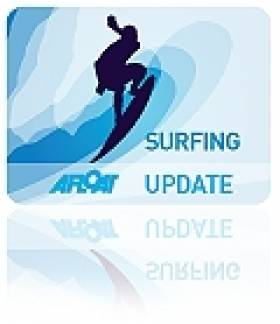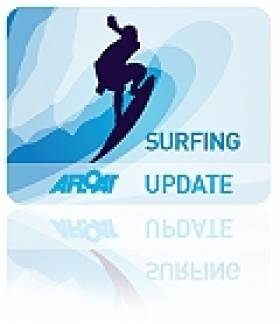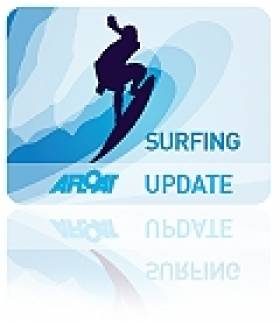Displaying items by tag: Garrett McNamara
Irish-American Big Wave Surfer Survives Jaw-Dropping Wipeout On Heavy Mavericks Break
#Surfing - Big storms bring big waves, as professional surfers in Ireland can attest on a regular basis.
It also means that the current El Niño conditions in the Pacific have attracted the cream of the world's big-wave surfers to California to take on a bounty of record-nudging monsters.
But such extreme sport comes with a high risk, as Irish-American surf pro – and record-breaker – Garrett McNamara knows only too well after wiping out last week on "one of the heaviest waves a human being has ever attempted paddling into", according to Outside magazine.
Video of the jaw-dropping moment has gone viral online, as McNamara is thrown like a rag doll from his board when the Mavericks break crashes over him.
Surf rescuer Frank Quirarte, who was watching events unfold, described it as “literally one of the worst wipe-outs I’ve seen in big wave surfing in a long time."
And the effects on McNamara were severe, as he required immediate surgery on a badly broken arm and shoulder – though he was lucky to escape with his life, let alone avoid more serious injury.
Outside has much more on the story HERE.
Surf Record Breaker Garrett McNamara Rides '100ft Wave'
#Surfing - Garrett McNamara has done it again - after riding what is claimed to be the largest wave ever surfed.
Last summer on Afloat.ie we reported that the Irish-American surfing pro had his previous world record attempt - a 78-foot monster off Portugal in November 2011 - confirmed by Guinness record-keepers.
But the Hawaiian wasn't content to rest on his laurels, and on a recent return visit to Nazaré he is said to have smashed his own record with a wave reported to be as much as 100ft in height.
The Guardian has video of McNamara's incredible attempt which you can view below - it's a sight that beggars belief!
McNamara's previous tow-in surf at Nazaré earned him the Biggest Wave title at the 2012 Billabong XXL Big Wave Awards. He shared his $15,000 prize money with Devon surfer Andrew 'Cotty' Cotton, who towed him by personal watercraft into the massive swell.
"Everything was perfect, the weather, the waves," said Northern Irish surfer Al Mennie, who was on hand to witness the pair at Praia do Norte.
#SURFING - It's official - an Irish-American surf pro did indeed ride the world's biggest wave, and will have his name in the Guinness Book of Records to prove it.
Record-keepers have confirmed that a 78-foot monster wave caught by Garrett McNamara off Portugal last November is the biggest ever surfed, according to BBC News.
As previously reported on Afloat.ie, the offshore area at Praia do Norte, off Nazaré, is noted for its deepwater canyon that channels massive swells from the Atlantic.
The tow-in surf also earned McNamara the Biggest Wave title at the 2012 Billabong XXL Big Wave Awards, the winners of which were announced this week.
Devon surfer Andrew 'Cotty' Cotton earned half a share of McNamara's $15,000 prize money as the one who towed him by personal watercraft into the massive swell.
"I feel so stoked for him, it was an amazing achievement," said Cotty, a fellow nominee for the Biggest Wave award - along with Ireland's Ollie O'Flaherty - for his efforts off Mullaghmore Head in March this year.
"Everything was perfect, the weather, the waves," said Northern Irish surfer Al Mennie, who was tow-in surfing with McNamara and Cotty when the giant swell arose at Praia do Norte.
“As I rode this wave, it seemed pretty massive, but I couldn’t tell quite how big it was,” McNamara told surf forecast site Surfline at the time. “When I got to the bottom and turned and got around the wave and went to kick out, it landed on me and it felt like a ton of bricks.
"Probably one of the most powerful waves ever to land on me at the shoulder," he added. "It was pretty amazing.”
Irish Surfer Needs Funds to Attend Big Wave Awards
#SURFING - A young surfer from Lahinch in Co Clare is in the running for the 'biggest wave' prize in the 2012 Billabong XXL contest for his monster ride at Mullaghmore Head, The Irish Times reports.
Ollie O'Flaherty, 24, is nominated along with Devon's Andrew Cotton for the massive surf they caught off Co Sligo on 8 March last.
It was the first visit to the world-class big wave spot by O'Flaherty, a science student at NUI Galway who is a veteran of the Co Clare scene.
As previously reported on Afloat.ie, it was Cotton who tackled the biggest wave on that day - a giant 50-footer - as some of the world's top surfers took advantage of the Viking swell.
Also nominated for the $50,000 (€38,280) prize is Irish-American surfer Garrett McNamara, who last year rode what is being called the biggest wave ever surfed in the world, a 90-foot goliath off Nazaré in Portugal.
According to the Irish Independent, O'Flaherty has put out a call for sponsorship so he can attend the awards ceremony next month.
"It's a massive honor to be able to represent Ireland," he said, but added that he is "pretty much on the breadline from what I'm doing".
Should he win, the Lahinch native said he intends to "put every cent back into surfing" and replace his seven broken boards.
The winners will be announced at the Billabong XXL Big Wave Awards in Anaheim, California on 4 May.
Irish-American Surfs 'World's Biggest Wave'
#SURFING - An Irish-American has ridden what's being called the biggest wave ever surfed in the world.
Garrett McNamara from Hawaii caught the 90-foot monster wave off the coast of Nazaré in Portugal earlier this month, The Irish Times reports.
"Everything was perfect, the weather, the waves," said Northern Irish surfer Al Mennie, who was tow-in surfing with McNamara and English rider Andrew Cotton when the giant swell arose at Praia do Norte.
The offshore area is noted for its deepwater canyon that channels massive swells from the Atlantic.
“As I rode this wave, it seemed pretty massive, but I couldn’t tell quite how big it was,” McNamara told surf forecast site Surfline.
“When I got to the bottom and turned and got around the wave and went to kick out, it landed on me and it felt like a ton of bricks.
"Probably one of the most powerful waves ever to land on me at the shoulder," he added. "It was pretty amazing.”
McNamara - whose family has Irish roots, according to Irish Central - is working with the Portuguese Hydrographic Institute as part of the ZON North Canyon Project, which aims to learn how waves reach such significant heights at Praia do Norte.
See video of the record-shattering wave ride below:


























